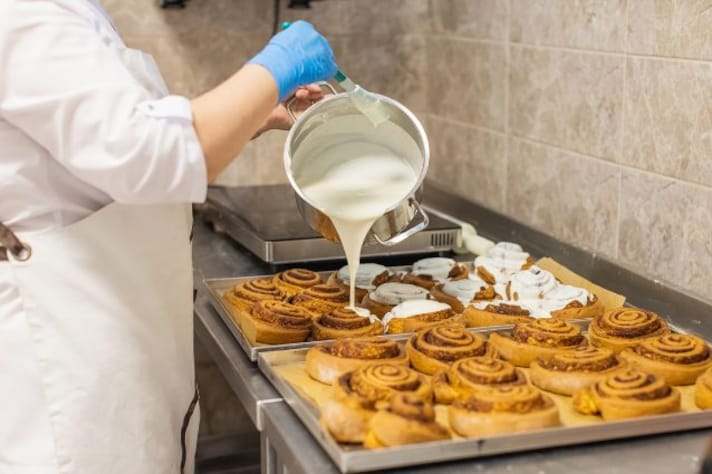What’s The Difference Between Frosting, Icing and Glaze? Your Definitive Guide!
Frosting, icing and glazes are all made differently, and they have specific uses for specific types of desserts. Do you still have some troubles differentiating between them? Read ahead for the complete overview of what they are, and how to use them at best in your baking adventures!

When it comes to desserts, there's no denying that frosting, icing, and glazing can elevate a simple cake or pastry into something spectacular. Whether you're making a layered cake, decorating cookies, or adding a shiny finish to a tart, these three sugary concoctions are essential for giving your treats that irresistible look and sweet taste. They can also work wonders for hiding a mistake—broke a layer of cake or need to cover a slightly lopsided edge? Frosting to the rescue!
But here’s the catch: while we often toss the words “frosting,” “icing,” and “glaze” around as though they’re interchangeable, they are, in fact, very different. Each one is designed for specific uses, and the technique for making them varies, too. So, let’s clear up the confusion and break down the key differences between these three essential dessert toppings.
What is Frosting?
Let’s start with frosting, the thick, creamy topping we all know and love, and for good reason—frosting can turn any simple dessert into a masterpiece. Frosting is typically made with a base of butter or shortening, combined with powdered sugar, and often flavored with extracts or chocolate. It’s rich, smooth, and can be spread, piped, or slathered generously onto cakes, cupcakes, and cookies.
There are several types of frosting, each with its own texture and flavor. Buttercream frosting is the most popular, known for its smooth, silky texture and sweet, buttery taste. It’s ideal for piping and decorating, making it a go-to for wedding cakes and fancy cupcakes. Cream cheese frosting has a tangy twist, making it a great choice for spiced cakes like carrot cake or red velvet. If you prefer something a little lighter, whipped cream frosting is fluffy and airy, perfect for topping fruit tarts or sponge cakes. For a rich, chocolatey finish, ganache frosting combines heavy cream and chocolate, yielding a luscious, glossy coat.

What is Icing?
Next up, icing. If frosting is the thick, hearty option, icing is its lighter, shinier cousin. Typically made from powdered sugar and a liquid (like milk, water, or citrus juice), icing has a thinner consistency than frosting. The real charm of icing lies in its ability to set hard and create a glossy finish—making it perfect for drizzling, dipping, or spreading on cookies and pastries.
The most common type of icing is royal icing, made from egg whites, powdered sugar, and sometimes a touch of lemon juice. It’s a favorite for decorating sugar cookies and gingerbread houses, as it hardens to a smooth, solid finish that can hold intricate designs and decorations. Glacé icing is another popular option; it’s simpler and thinner, typically just powdered sugar and water, and is ideal for glazing cakes, donuts, and even éclairs.
Unlike frosting, which is usually piped onto cakes in large quantities, icing tends to be more delicate, often used for drizzling over a cake or lightly coating a pastry. It’s sweet and smooth, with a satisfying shine, but it won’t offer the same thick, creamy indulgence that frosting does.

What is Glaze?
Then, there’s glaze, the often overlooked but vital topping that adds a touch of elegance to many baked goods. Glaze is typically a simple mixture of sugar (usually powdered) and a liquid, but what sets it apart is its thin, almost syrupy consistency. When you pour or brush it over baked goods, it creates a smooth, shiny coating that dries to a delicate finish.
There are many types of glazes, from the classic sugar glaze, made with powdered sugar and milk or water, to more complex versions that include fruit juice or citrus zest for an added punch of flavor. Chocolate glaze, which combines melted chocolate and cream, is perfect for finishing off cakes, donuts, and pastries with a glossy, decadent touch. Mirror glaze—an Instagram favorite—is a highly glossy, smooth topping that’s typically poured over mousse cakes or entremets, creating a glass-like effect. It requires a precise technique, but the end result is nothing short of stunning.
Glaze is generally used for finishing off cakes or pastries that need a bit of extra shine, and unlike icing or frosting, it’s not typically spread or piped. It adds a layer of flavor and visual appeal, making it perfect for a light touch of sweetness.

When to Use Frosting, Icing, or Glaze?
Now that you know the ins and outs of frosting, icing, and glaze, how do you choose which one to use? The decision comes down to texture, purpose, and aesthetic.
- Use frosting when you want something thick and spreadable. It’s ideal for large cakes, cupcakes, or cookies that need a sturdy layer of sweetness. If you’re making a birthday cake or a wedding cake, frosting is the way to go. It’s perfect for creating smooth, layered looks, intricate piping designs, or simple, rustic finishes.
- Use icing when you want a glossy, smooth finish with a bit of delicacy. If you’re decorating sugar cookies, glazing donuts, or creating simple designs that don’t need the thickness of frosting, icing is your best option. It’s also perfect for making royal icing designs on gingerbread houses or as a light coating for pastries.
- Use glaze when you need a shiny, sweet finish that’s light and elegant. For cakes that need a beautiful glaze (like a fruit cake or a bundt cake), a glaze is your best friend. It’s also great for donuts, éclairs, or any pastry that benefits from a thin, glossy coat.
;Resize,width=767;)

;Resize,width=712;)
;Resize,width=712;)
